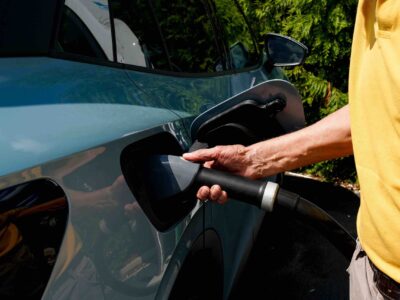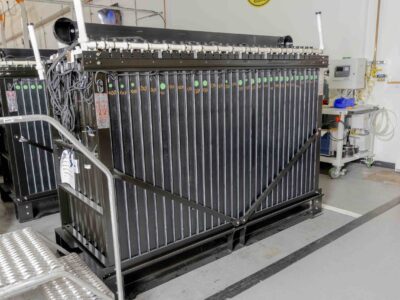When George Washington University (GW) updated its Charles E. Smith Center in the late 2000s, the school aimed to achieve a silver Leadership in Energy and Environmental Design (LEED) certification from the U.S. Green Building Council. However, the renovation job was so successful that GW’s main athletics and recreation center — home to its Men’s and Women’s Basketball, Volleyball, Gymnastics, Men’s and Women’s Swimming and Diving, and Men’s Water Polo, among other sports — received the coveted gold certification in 2012.
“As a team, we really have created a dynamic new space for the GW community, and importantly, one that includes numerous sustainable features,” Alicia Knight, former senior associate vice president for operations, shared with GW Today when the gold certification was announced in 2012.
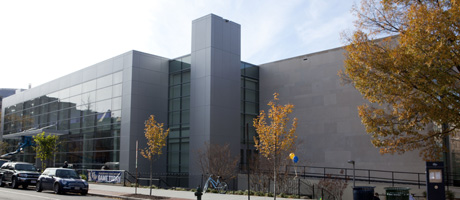
Photo Courtesy GW Today
The decision to renovate rather than tear down the 1970s-era facility was significantly inspired to limit the project’s environmental impact. This mindset continued through the designing and revamping of the Smith Center.
During the building process, more than 90% of waste was either salvaged or recycled instead of winding up in landfills or some type of incineration facility. Indoor air contaminant levels were reduced because construction items, like paint, carpeting, adhesives, and sealants, had to meet Green Seal Standards or Green Label Plus requirements for low volatile organic compounds.
The work done on the Smith Center allowed it to operate at a highly proficient environmental level due to the inclusion of energy-efficient windows, an Energy Star white roof, and well-insulated exterior wall systems.
State-of-the-art mechanical systems, including variable volume HVAC and natatorium dehumidification units, also served to limit energy waste.
Additionally, the installation of low-flow plumbing fixtures and the planting of native or adaptive flora — which needs no permanent irrigation — helped to lower water usage by more than 40% compared to the standard baseline for a similar commercial building. These structural features factored into the Smith Center being placed fifth among the nation’s “greenest” college basketball arenas in a 2017 LawnStarter ranking.
Several sustainability measures launched at the Smith Center arose from student-athlete suggestions. Members of the men’s and women’s rowing teams, who train during the winter months at the venue, successfully suggested that the old-fashioned and water-wasteful water fountain in the “rowing corner” be replaced with two water bottle filling fountains.
The change saved more than 17,000 bottles in the first six months alone. Rowers also recommended switching from paper to cloth towels, eliminating around 425 sheets of paper towels a week.
As part of GW’s Solar For All program, the Smith Center stands as one of the campus’ handful of buildings with roof-top solar panels. They have a 437 kWAC capacity and decrease greenhouse gas emissions equal to the amount created by eliminating approximately 90 cars from the roads annually. Furthermore, the university has a small photovoltaic solar walkway array on its Virginia Science and Technology Campus and solar thermal systems to heat water in several dorms on its Foggy Bottom campus.
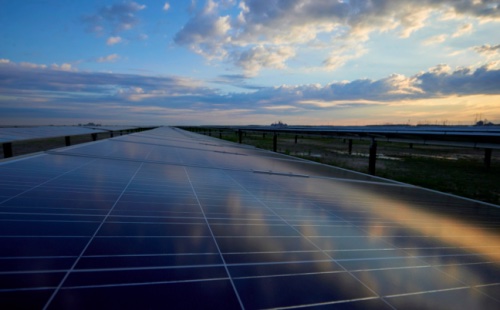
Photo Courtesy Sustainable GW
The GW athletic department has launched several operational initiatives that have further improved the department’s environmental profile. Food waste, such as fruit peels and used coffee grounds from the Smith Center’s kitchen facility, gets composted. Items are diverted from landfills and used at the local GW vegetable garden, and leftovers from team meals are collected and dropped off at local food banks.
The athletic department also uses cutlery and other serving products made from plant-based cornstarch, banana leaf-based bowls and plastics, and cold and hot beverage cups created from 100% renewable resources and plant-based plastic.
All of GW’s athletic fields feature synthetic turf, a surface that doesn’t require the water and chemicals that grass fields need.
These steps were all highlighted when the Association for the Advancement of Sustainability in Higher Education awarded GW a gold Sustainability Tracking, Assessment & Rating System (STARS) honor in 2020.
The STARS’ recognition, along with the other green-geared efforts, underscores the university’s concern with protecting the environment. GW joined the American College and University Presidents’ Climate Commitment (ACUPCC) early on. By 2010, the school had published its own Climate Action Plan, which it has updated — and accelerated — in the years since.
Projects have included fixing thousands of faucets and showerheads, turning a parking lot into a reclaimed green space, assuming a Zero Waste objective, and pledging a commitment to eliminate single-use plastics on its campuses.
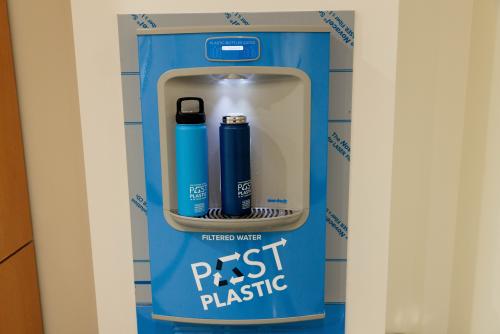
Photo Courtesy Sustainable GW


